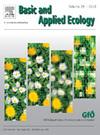澳大利亚的绿色屋顶吸引了具有相似功能特征的蜜蜂,但对当地属性的物种特异性反应差异很大
IF 3.5
2区 环境科学与生态学
Q2 ECOLOGY
引用次数: 0
摘要
蜜蜂是重要的传粉媒介,但由于气候和土地利用变化的影响,例如与城市化相关的栖息地丧失和城市热岛,蜜蜂在全球范围内数量正在减少。绿色屋顶可以为城市蜜蜂提供资源和栖息地。然而,目前尚不清楚绿色屋顶的属性如何影响它们的栖息地价值。为了更好地了解绿色屋顶的生物多样性价值,了解哪种类型的绿色屋顶最能支持本地蜜蜂以及影响这一点的属性是至关重要的。在2019/20年夏季,采用主动和被动抽样方法对墨尔本20个绿色屋顶上的蜜蜂进行了调查。利用地理信息系统(GIS)对绿化屋顶的局部属性和景观属性进行实地采集和空间分析。共鉴定了20种利用绿色屋顶的蜜蜂。广义线性模型(GLM)和物种群落分层模型(HMSC)发现,周围景观中的不透水地面覆盖是蜜蜂丰度和丰富度的强烈负向预测因子。此外,增加绿色屋顶上的觅食资源对蜜蜂的丰度和丰富度有积极的影响。离地高度对一些蜜蜂种类有负面影响,但它们的体型不是一个影响因素。这些发现对绿色屋顶种植设计具有重要意义,并表明含有多样性花卉资源的较低高度屋顶最适合支持多样化的本地蜜蜂群落。本文章由计算机程序翻译,如有差异,请以英文原文为准。
Australian green roofs attract bees with similar functional traits, but species-specific responses to local attributes differ significantly
Bees are important pollinators but are globally in decline due to the effects of climate and land use change, for example loss of habitat and urban heat island associated with urbanisation. Green roofs can provide resources and habitat for urban bees. However, it is unclear how the attributes of green roofs influence their habitat value. To better understand the biodiversity value of green roofs, it is crucial to understand what type of green roofs best support native bees and the attributes that affect this. A mix of active and passive sampling methods were used to survey bees from 20 green roofs in Melbourne during summer 2019/20. Local and landscape attributes of the green roofs were collected in the field or via spatial analysis using GIS. A total of 20 bee species utilising green roofs were identified. Generalised linear models (GLM) and hierarchical modelling of species communities (HMSC) found that impervious ground cover within the surrounding landscape was a strong negative predictor for bee abundance and richness. Further, increased foraging resources on the green roofs had positive effects on bee abundance and richness. Height above ground had a negative effect on some bee species, but their body size was not an influencing factor. These findings are important for green roof planting design and suggest that roofs lower in height that contain a diversity of floral resources are most suited to support diverse native bee communities.
求助全文
通过发布文献求助,成功后即可免费获取论文全文。
去求助
来源期刊

Basic and Applied Ecology
环境科学-生态学
CiteScore
6.90
自引率
5.30%
发文量
103
审稿时长
10.6 weeks
期刊介绍:
Basic and Applied Ecology provides a forum in which significant advances and ideas can be rapidly communicated to a wide audience. Basic and Applied Ecology publishes original contributions, perspectives and reviews from all areas of basic and applied ecology. Ecologists from all countries are invited to publish ecological research of international interest in its pages. There is no bias with regard to taxon or geographical area.
 求助内容:
求助内容: 应助结果提醒方式:
应助结果提醒方式:


